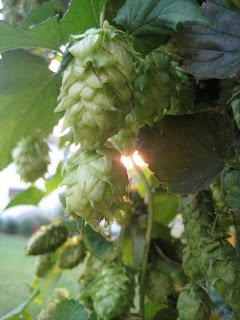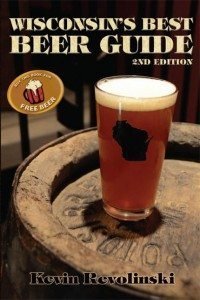
There are towering plants you’ll find growing in Oshkosh that smell of beer. They are hop plants and the cones that flower from them provide the distinctive aroma and tang of bitterness that is essential to beer. The hops growing in Oshkosh these days are often tended by homebrewers for use in their brewing. Unknown to many of these brewers, they’re also cultivating a connection to Oshkosh’s past.
It began more than 150 years ago. The Johnny Appleseed of hops in Oshkosh was a man named John Braley. Born in Vermont in 1819, Braley moved to Winnebago County in the early 1850s. He may have arrived with hop rhizomes in tow. During the 1840s, Braley worked as a farmer in the heart of Vermont’s hop belt at a time when hop production there was booming. Other Vermonters took their hops to California and, in turn, seeded the major hop growing regions of the Pacific Northwest. Braley came to Oshkosh.
In June 1850, John Braley purchased 53 acres of land from the estate of the recently deceased James Knaggs, the legendary Oshkosh ferryman. Braley continued buying property in what would become Oshkosh until he had amassed more than 100 acres. His land was shoulder to shoulder with what would become Riverside Cemetery. It was bounded on the south by what is now Murdock Ave.; on the east by Vinland St.; and ran as far north as Winchester Ave.
Braley’s first crop of hops were picked in the late summer of 1854. He wanted word to get out about his endeavor, so Braley took some of his cuttings into town. The editor of the
Oshkosh Daily Courier was impressed.
HOPS.—We were shown on Saturday last some very fine samples of Hops which were raised on the farm of Mr. JOHN BRALEY, near this city. We are not aware that the cultivation of Hops has heretofore been attempted in this country, but should think from the success which has attended MR. BRALEY'S efforts this season, that our farmers would do well to direct their attention to this matter.
Oshkosh Daily Courier, September 11, 1854
The Hop Craze Hits Oshkosh
 |
| Wisconsin Hop Pickers in the 1860s |
Braley’s timing was just about perfect. Oshkosh already had two breweries. Four more were on their way. And within 30 miles of Oshkosh, another nine breweries were either already in operation or soon to be. They all needed hops. Increased demand helped to cause a spike in hop prices, which more than doubled over the coming decade. By 1865, hops in Winnebago County were selling for as much as 65 cents a pound. It wasn’t long before Braley found himself just one of many hop farmers in the area. The
“hop craze” was on.
By the early 1860s, Wisconsin was growing 20 percent of the nation’s hops with Winnebago County becoming the fourth largest producer in the state. The county’s hop production grew prodigiously, going from 17,000 pounds in 1860 to 67,000 pounds by 1865. The production spike would continue as the decade progressed. Delhi, just west of Omro, grew into the epicenter of hop production in Winnebago County. Much of Delhi’s productive acreage was devoted to hop farming. The small village was home to three hop mills and a hop press and at harvest time armies of pickers would flow into Delhi. After drying and baling, the hops were sent by boat to Oshkosh for distribution to breweries here and beyond.

If you’re a drinker of hop-forward beers, you’ve probably begun to wonder what sort of hops were being grown here in the 1800s. Agricultural reports from the period rarely specify the type of hop being grown, but when names do arise the variety that tends to be mentioned is Cluster. Though there are no true landrace, or native, hops grown in America, Cluster is about as close as you’ll get to an indigenous strain. Its genetic make-up shows a mix American and European stock that resulted from cross-pollination of native plants with plants from Europe. The breed grows exceedingly well in this area and was a varietal that a grower such as Braley would have almost certainly been familiar with.
John Braley sold his farm in 1866 and moved to Fond du Lac, but hop growing in this area was now firmly established. Hop farms were springing up even within the city limits of Oshkosh. Because hops grow vertically, often as high as 25 feet, it was possible for city dwellers to develop an urban plot into a somewhat lucrative piece of farmland. During the latter half of the 1860s, hop yards dotted the city. Hops were being grown on the east side of Oshkosh on Pearl Ave.; on the north side on Jackson St.; and west of the river on Punhoqua St. In 1865, the
Oshkosh Daily Northwestern chimed in on the hop explosion. The paper foretold that, “Hereafter (hops) will constitute a very important item in the production of this county.”
That prediction was dead wrong. Overproduction led to a crash in hop prices and the subsequent disruption of hop growing here. In 1870, Winnebago County produced 175,000 pounds of hops. Within 10 years, hop production in the county had dwindled to less than 25,000 pounds. Compounding the drop in prices was the loss of the local market. Brewing in Oshkosh was being transformed during the period into an industrial enterprise. As that happened, the tie to local agriculture diminished. Brewers were now sourcing their ingredients from brokers who offered hops from as far away as Bohemia. The “hop craze” had ended and it took the hop yards of Oshkosh with it. It would be another 40 years before people in Oshkosh began growing hops again for brewing. It would take a strident, overreaching law to inspire the return of hop growing in the city.
A Second and Third Wave
Prohibition weaseled its way into Oshkosh in 1919 and found few friends upon its arrival. Beer may have suddenly become illegal, but that didn’t stop the people of Oshkosh from drinking it. And the new “near beers” being made here were no substitute for the real thing. Historian Inky Jungwirth grew up on the south side of Oshkosh and remembers the attitude of his elders. “The 6th ward had a big German population and those people demanded the best beer,” Jungwirth says. One way or another, they were going to have it.
Throughout the 1920s, homebrewing flourished in Oshkosh. On a larger scale, wildcat breweries were established that began producing beer in quantity. Local hops were again in demand and an underground market sprang up to supply them. “Hop production in this area took off like a jet stream,” Jungwirth says. But it appears to have almost as quickly been grounded. When Prohibition ended in 1933, legal beer returned. The wildcat brewers went out of business and homebrewing all but vanished. Once again, there was little call for hop growers in Oshkosh.
 |
| Hops growing in Oshkosh |
The seed of the third wave of hop growing in Oshkosh was planted in 1978 when federal restrictions were removed on beer brewed at home for personal use. The homebrewing scene in Oshkosh gathered steam throughout the 1980s and in 1991 the city’s first homebrew club, the Society of Oshkosh Brewers, was established. As homebrewers grew adept at crafting quality beer, some began turning their attention to sourcing their own ingredients. Growing hops became a natural extension of their hobby. By the mid-1990s, several members of the Society of Oshkosh Brewers were growing their own hops for use in the beer they made.
Today you can again find hops growing in almost every section of the city. In terms of poundages produced we’re no match for the hop growers of the 1870s, but when it comes to variety we’ve far surpassed our forebears. This is my fourth summer growing hops and I find myself typical of other hop gardeners I’ve met. I grow six varieties of hops and usually produce more cones than I can possibly use in a year of homebrewing. The plants grow fast and tall and by July some have already reached a height of 20 feet. This summer looks to be an especially bountiful one. I’m expecting a yield of excellent quality when I harvest in early September. Perhaps they’ll be the equal of the “very fine samples” that John Braley first raised here in 1854.
 The typing here will cease for a couple weeks while I do some summer beer hunting. And guiding my stumble will be Wisconsin’s Best Beer Guide by Kevin Revolinski. This is the second edition of Revolinski’s field manual for beer drinking in our state. It has everything you could want in a barley-based travelogue.
The typing here will cease for a couple weeks while I do some summer beer hunting. And guiding my stumble will be Wisconsin’s Best Beer Guide by Kevin Revolinski. This is the second edition of Revolinski’s field manual for beer drinking in our state. It has everything you could want in a barley-based travelogue.













